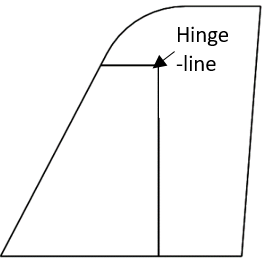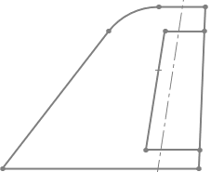This set of Aircraft Design Multiple Choice Questions & Answers (MCQs) focuses on “Control-Surface Sizing”.
1. If a wing has span of 12m. Find the approximated length of the aileron of starboard wing.
a) 2.4m
b) 20m
c) 15m
d) 25m
View Answer
Explanation: For a typical wing, ailerons are extended from 50% of span to 90% of span.
Given, Span of wing b=12m. Since we need to find aileron length at one wing we will divide total wing span by 2.
Hence span of starboard wing = 12/2 = 6m.
Length of aileron at starboard wing (right wing) = |difference between 50% and 90% of span|
= |50% of 6m – 90% of 6m| = |0.5*6-0.9*6| = 2.4m.
2. High speed aircraft is affected by ____________
a) aileron reversal
b) flap inversion
c) drafting
d) independent from any disturbances
View Answer
Explanation: Typical high speed aircrafts are affected by ‘aileron reversal’. Aileron reversal is generated as a result of much complex air loads. Air loads are strong enough that they twits wing itself. This results in wrong way rolling at certain speeds.
3. We can reduce aileron reversal by adopting ____________
a) inboard aileron
b) inboard fuel
c) thrust reversal
d) thrust decrement
View Answer
Explanation: To reduce the degree of aileron reversal we often use an inboard aileron. Inboard aileron will reduce the excessive twisting of wing. Thrust reversal are used to decelerate aircraft.
4. Rolling tails can be used by high speed A/C.
a) True
b) False
View Answer
Explanation: Rolling tail is nothing but the horizontal tail. This horizontal tail can be deflected nonsymmetrically. Rolling tails are used for decrease the effect of aileron reversal.
5. Determine the corrections or otherwise of the following assertion [A] and reason [R]:
Assertion [A]: Typically control surface are tapered with same taper ratio as primary component such as wing or tail
Reason[R]: Control surface is used to provide trim control to the A/C
a) Both [A] and [R] are true and [R] is the correct reason for [A]
b) Both [A] and [R] are true but [R] is not the correct reason for [A]
c) Both [A] and [R] are false
d) [A] is false but [R] is true
View Answer
Explanation: Control surface is used to provide control to the aircraft. In general, we provide same taper ratio to the control surface as wing or tail. By using same taper ratio we can ensure that constant percent chord is being maintained by the surface.
6. Rapid oscillations of control surface due to application of the air loads is termed as __________
a) control surface flutter
b) control surface span
c) control surface trim
d) control surface effectiveness
View Answer
Explanation: Rapid oscillation of control surface is called control surface flutter. This rapid oscillation can tear off the surface or wing/tail itself. This will induces excessive vibration as well. Effectiveness of control surface is measure of how effectively we can control the aircraft.
7. Following diagram represents ______

a) notched aerodynamic balance
b) fluttered balance
c) overhorn balance
d) overhung balance
View Answer
Explanation: Above diagram is showing a typical notched aerodynamic balance. It is also called horn aerodynamic balance. We can reduce the force required for deflecting the control surface. However, it is not suitable for high speed aircrafts.
8. Following diagram represents _____

a) overhung aerodynamic balance
b) overhorn balance
c) horn balance
d) notched balance
View Answer
Explanation: Overhung aerodynamic balance is represented in the above diagram. It is used to reduce the amount of force require to deflect a control surface. It is also used to reduce the flutter effect.
9. Determine elevator chord if tail chord is 1m.
a) 0.25m-0.5m
b) 2.5m
c) 1.8m
d) 1.5-2m
View Answer
Explanation: Given, tail chord T.C. = 1m.
In typical aircraft, elevator chord is 25% to 50% of tail chord.
Elevator chord = 25% of T.C. to 50% of T.C. = 25% of 1 to 50% of 1
= 0.25*1 to 0.5*1 = 0.25m-0.50m.
10. If vertical tail has length of the 2m then, find the value of rudder length.
a) 1.8m
b) 2.8m
c) 2m
d) 2.5m
View Answer
Explanation: Given vertical length L = 2m.
For, typical aircraft rudder is extended up to 90% of the length of the vertical tail.
Hence, Rudder length = 90% of tail length = 90% of 2m = 0.9*2m = 1.8m.
Sanfoundry Global Education & Learning Series – Aircraft Design.
To practice all areas of Aircraft Design, here is complete set of 1000+ Multiple Choice Questions and Answers.
If you find a mistake in question / option / answer, kindly take a screenshot and email to [email protected]
- Check Aircraft Design Books
- Practice Aeronautical Engineering MCQs
- Practice Aerospace Engineering MCQs
- Check Aeronautical Engineering Books
- Check Aerospace Engineering Books
